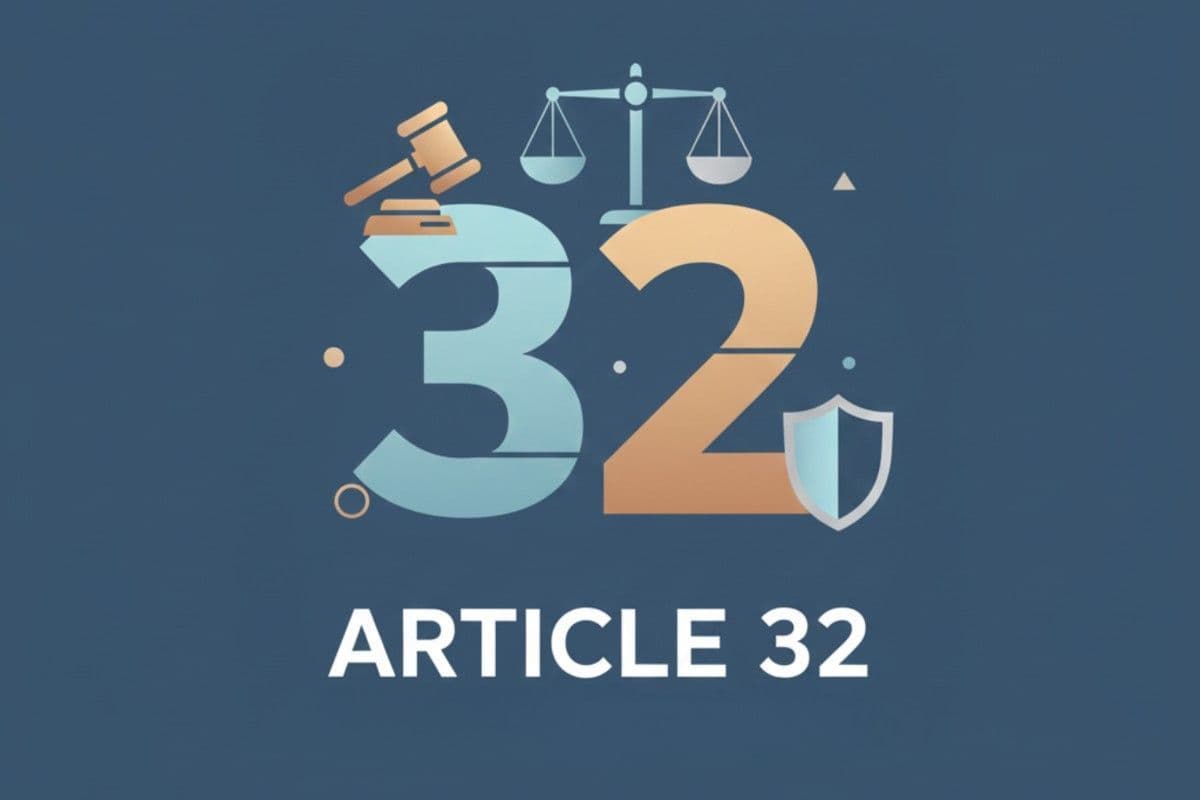Artificial Intelligence: Definition, Types, India’s Initiatives, AI Action Summit 2025
Oct, 2025
•4 min read
Artificial Intelligence (AI) is a crucial topic for the UPSC CSE Prelims and Mains. It is featured in GS Paper 3 and current affairs sections, testing knowledge of AI’s applications, challenges, and India’s role in AI development and regulations.
Here, we’ll cover everything you need to know about Artificial Intelligence UPSC from the syllabus perspective.
What is Artificial Intelligence?
Artificial Intelligence (AI) is a part of computer science that focuses on making machines work like humans. It enables computers to perform tasks such as learning, thinking, understanding language, and solving problems. AI uses data, algorithms, and computer power to make smart decisions, just like humans do.
Key Characteristics of AI:
- Machine Learning (ML): A Subfield where algorithms improve performance with experience.
- Deep Learning (DL): Advanced neural networks handling complex pattern recognition.
- Natural Language Processing (NLP): Enables machines to interpret, generate, and respond in human language.
- Computer Vision: Empowers machines to analyze and interpret visual inputs.
- Expert Systems: Rule-based AI that mimics the decision-making of human experts.
- Autonomous Systems: Self-governing machines like drones and robots.
Brief Historical Timeline of Artificial Intelligence
The story of Artificial Intelligence (AI) shows how machines became smarter over time. Here’s a quick look at the main events that shaped its journey.
- 1943: Warren McCulloch and Walter Pitts present the first model of artificial neurons, considered the beginning of AI.
- 1950: Alan Turing proposed the Turing Test to assess machine intelligence.
- 1956: John McCarthy coins the term "artificial intelligence" and organizes the Dartmouth conference, marking AI's birth.
- 1961: General Motors installs Unimate, the first industrial robot.
- 1964-1966: Joseph Weizenbaum develops ELIZA, the first natural language processing program.
- Late 1960s-1970s: Development of expert systems and neural networks; AI experiences initial enthusiasm and later setbacks (AI Winter).
- 1980s: Neural networks with backpropagation gain prominence. Expert systems are widely used.
- 1997: IBM's Deep Blue beats world chess champion Garry Kasparov.
- Early 2000s: AI was integrated into consumer products like the Roomba robotic vacuum and Apple's Siri.
- 2011: IBM Watson wins Jeopardy!, demonstrating natural language processing and knowledge retrieval.
- 2016: DeepMind's AlphaGo defeats world Go champion Lee Sedol.
- 2020-2024: Rise of large language models like OpenAI's GPT series and widespread applications in conversation and content generation.
Also read: Mission Sudarshan Chakra: India’s Indigenous Air Defense System
Classification of Artificial Intelligence
AI systems are classified by their capability and operational scope.
- Narrow (Weak) AI: Excels at specific tasks, e.g., virtual assistants.
- General (Strong) AI: Hypothetical AI matching human cognitive abilities.
- Superintelligent AI: Future AI surpassing human intellect across domains.
- Reactive Machines: No memory, react solely to present inputs.
- Limited Memory: Use historical data for decision-making, e.g., autonomous vehicles.
- Theory of Mind (Future): Understand human emotions and intentions.
- Self-Aware AI (Future): Machines possessing self-consciousness.
What are the Elements of Artificial Intelligence?
Artificial Intelligence is built on several essential elements that work together to enable machines to perform intelligent tasks. Here are the key elements:
1. Data: The raw information and examples used to train AI models. Large and quality datasets are crucial for accurate learning.
- Example: For a weather prediction system, we feed it years of temperature, humidity, and rainfall data.
2. Algorithms: Step-by-step procedures or formulas that teach machines how to process data and generate outputs.
- Example: A navigation app uses algorithms to find the shortest route between two places.
3. Computing Power: High-performance processors such as CPUs, GPUs, and TPUs that enable fast calculations needed for AI tasks.
- Example: Tesla's self-driving cars have powerful computers inside to process road information instantly.
4. Neural Networks: Complex models inspired by the human brain that help AI recognize patterns and learn from data.
- Example: Medical AI systems can spot diseases in X-rays by recognizing patterns doctors might miss.
5. Sensors & IoT Devices: Hardware tools that collect real-time data from the environment, enabling AI to perceive the world.
- Example: Health monitoring devices use sensors to track your heart rate and steps.
6. Human Expertise: The involvement of domain experts and data scientists to design, train, and validate AI systems, ensuring accuracy and ethical standards.
- Example: Doctors work with AI diagnostic tools to ensure accurate medical advice.
Also read: Bharat Forecast System: Launch, Objectives & Key Details
How Does AI Work?
AI systems operate by processing data through various stages, enabling machines to learn, decide, and act intelligently. The typical AI workflow includes these key stages:
- Data Collection: Gathering raw data from various sources such as sensors, databases, or web scraping.
- Data Preprocessing: Cleaning and transforming raw data to make it suitable for modeling.
- Feature Extraction: Identifying relevant features that influence the model’s decisions.
- Model Training: Algorithms learn patterns from data during this stage, adjusting internal parameters.
- Model Validation: Testing the trained model on new data to check accuracy and avoid overfitting.
- Deployment: Integrating the model into applications or devices for real-time decision-making.
- Feedback & Improvement: Continuously learning from new data to improve accuracy.
Also read: Fintech in India
Applications of Artificial Intelligence UPSC
Artificial Intelligence is used in many fields to make tasks easier, faster, and smarter, with real-life examples for better understanding.
- Healthcare: AI helps detect diseases early. For example, Google's AI can spot eye diseases from retina scans.
- Agriculture: AI monitors crops and predicts yields. Precision farming techniques use AI drones to check crop health.
- Education Sector: AI is revolutionizing learning by offering personalized study plans. Tools like SuperKalam use AI to empower students with personalized mentorship for UPSC CSE in a discipline-inducing learning ecosystem.
- Finance: AI spots fraud in banking transactions. Banks use AI chatbots like HDFC’s Eva to handle customer queries.
- E-Commerce: AI recommends products, as Amazon does with personalized suggestions.
- Transportation: AI drives cars autonomously. TATA and Mahindra’s self-driving cars use AI for navigation and safety.
- Government: AI chatbots provide citizen services, like MyGov Assist in India. AI also helps plan public projects using data analytics.
- Manufacturing: AI detects defects on assembly lines automatically, improving quality.
- Cybersecurity: AI monitors networks and blocks cyber-attacks, used by companies like IBM Security.
Examples of AI in Daily Life
Artificial Intelligence quietly powers many of the tools and services we use every day, making tasks faster, easier, and more personalized.
- Voice Assistants: Asking Siri or Google Assistant to set reminders, play music, or answer questions.
- Navigation Apps: Google Maps and Waze use AI to find the fastest routes and predict traffic conditions.
- Language Translation: Apps like Google Translate instantly convert text or speech between languages.
- Health Trackers: Wearables like Fitbit analyze your activity and sleep patterns to give personalized health insights.
- SuperKalam Answer Evaluation: SuperKalam’s AI tool assesses and scores UPSC-style answers, providing feedback to improve writing skills.
Multiple Choice Questions
QUESTION 1
Medium
With reference to AI applications in Indian governance, consider the following:
1.Bhashini platform uses AI to provide government services in regional languages 2.SUVAS is an AI-based translation tool for legal proceedings 3.Supreme Court uses SUPACE for AI-powered legal research assistance
Which of the statements given above are correct?
Select an option to attempt
Advantages and Disadvantages of Artificial Intelligence
AI brings transformative benefits along with new challenges.
| Advantages | Disadvantages |
|---|---|
| Speed and Efficiency: AI processes information much faster than humans, completing tasks in seconds. | Job Displacement: Automation may replace human workers in various industries. |
| 24/7 Availability: AI systems work continuously without breaks, holidays, or sick days. | High Initial Costs: Setting up AI systems requires significant investment in hardware and software. |
| Accuracy and Precision: Reduces human errors in calculations, medical diagnosis, and data analysis. | Lack of Creativity: AI cannot think creatively or come up with truly original ideas like humans. |
| Medical Breakthroughs: Helps detect diseases early and assists in complex surgeries. | Ethical Dilemmas: Difficult decisions about AI behavior in situations like self-driving car accidents. |
| Improved Decision Making: Analyses vast amounts of data to provide better insights for business and policy. | Lack of Emotional Intelligence: Cannot understand human emotions or provide genuine empathy. |
Also read: Aero India 2025
India and Artificial Intelligence
India is actively adopting AI technologies to drive growth, enhance public services, and address social challenges through targeted policies and strategic collaborations.
- National AI Strategy: Launched by NITI Aayog, focusing on healthcare, agriculture, education, smart cities, and infrastructure.
- AI Centers of Excellence: Established in states like Punjab, Kerala, and Telangana to promote research and innovation.
- AI4Bharat Initiative: Develops AI solutions in Indian languages for wider accessibility.
- Startups: India’s growing AI startup ecosystem focuses on fintech, healthtech, agritech, and edtech.
- Skill Development: Government programs train youth and professionals in AI and machine learning skills.
- AI Ethics & Regulation: Steps taken to ensure responsible AI use with privacy and fairness frameworks.
- Public Services: AI-powered chatbots and data analytics improve government-citizen interaction and policy-making.
These initiatives highlight India’s significant steps in making AI an engine of inclusive development.
AI Action Summit 2025: Key Highlights
The AI Action Summit 2025 was a global event co-chaired by India and France, focusing on responsible AI development, innovation, governance, and inclusivity.
- The summit was co-chaired by Prime Minister Narendra Modi and French President Emmanuel Macron in Paris on 11 February 2025.
- The summit emphasized AI’s power in transforming healthcare, education, finance, and security while addressing challenges like bias in training data.
- PM Modi highlighted the importance of collective global action to create ethical AI frameworks, promote innovation, and ensure AI access for all, especially in the Global South.
- India announced it would host the next AI Summit in 2026, showcasing its AI initiatives like Digital Public Infrastructure and Large Language Models.
- The summit resulted in the Statement on Inclusive and Sustainable Artificial Intelligence for People and the Planet, supporting AI accessibility, transparency, accountability, and innovation.
- India became a founding member of the Coalition for Environmentally Sustainable AI, promoting AI that is eco-friendly and socially responsible.
UPSC Mains Practice Question
Discuss how Artificial Intelligence (AI) is being leveraged to transform governance in India. Examine the key challenges in its deployment and suggest measures to harness AI for inclusive and efficient public service delivery.
Evaluate Your Answer Now!Way Forward
To maximize AI’s benefits, India must pursue balanced policies, inclusive growth, and robust governance.
- Strengthen Regulations: Enact comprehensive data protection and AI governance frameworks.
- Promote Partnerships: Encourage collaboration between government, industry, academia, and civil society.
- Scale AI in Governance: Deploy AI tools for transparent and efficient public service delivery.
- Expand Skill Ecosystem: Integrate AI education into school and higher education curricula; support vocational training.
Also read: Which AI Platform is Best for UPSC Preparation in 2025: ChatGPT vs SuperKalam.
Unlock your UPSC potential with SuperKalam-get instant doubt resolution, personalized study plans, unlimited MCQ practice, and rapid Mains answer evaluation.
Join thousands of aspirants excelling with India’s leading AI-powered super mentor today!


